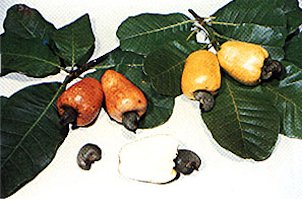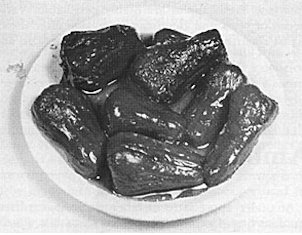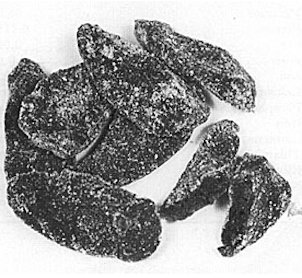From the book
Fruits of Warm Climates
by Julia F. Morton
Cashew Apple
Anacardium occidentale L.
ANACARDIACEAE
This pseudofruit (or "false fruit") is a by-product of the cashew nut industry. The cashew tree, Anacardium occidentale
L., is called marañon in most Spanish-speaking countries, but merey in
Venezuela; and caju or cajueiro in Portuguese. It is generally bushy,
low-branched and spreading; may reach 35 ft (10.6 m) in height and
width. Its leaves, mainly in terminal clusters, are oblong-oval or
obovate, 4 to 8 in (10-20 cm) long and 2 to 4 in (5-10 cm) wide, and
leathery. Yellowish-pink, 5-petalled flowers are borne in 6 to 10-in
(15-25 cm) terminal panicles of mixed male, female and bisexual. The
true fruit of the tree is the cashew nut resembling a miniature
boxing-glove; consisting of a double shell containing a caustic
phenolic resin in honeycomb-like cells, enclosing the edible
kidney-shaped kernel. An interesting feature of the cashew is that the
nut develops first and when it is full-grown but not yet ripe, its
peduncle or, more technically, receptacle, fills out, becomes plump,
fleshy, pear-shaped or rhomboid-to-ovate, 2 to 4 1/2 in (5-11.25 cm) in
length, with waxy, yellow, red, or red-and-yellow skin and spongy,
fibrous, very juicy, astringent, acid to subacid, yellow pulp. Thus is
formed the conspicuous, so-called cashew apple.

Plate XXX: CASHEW APPLE, Anacardium occidentale
The
cashew is native to and northeast Brazil and, in the 16th Century,
Portuguese traders introduced it to Mozambique and coastal India, but
only as a soil retainer to stop erosion on the coasts. It flourished
and ran wild and formed extensive forests in these locations and on
nearby islands, and eventually it also became dispersed in East Africa
and throughout the tropical lowlands of northern South America, Central
America and the West Indies. It has been more or less casually planted
in all warm regions and a few fruiting specimens are found in
experimental stations and private gardens in southern Florida
The
production and processing of cashew nuts are complex and difficult
problems. Because of the great handicap of the toxic shell oil, Latin
Americans and West Indians over the years have been most enthusiastic
about the succulent cashew apple and have generally thrown the nut away
or processed it crudely on a limited scale, except in Brazil, where
there is a highly developed cashew nut processing industry, especially
in Ceara. In Mozambique, also, the apple reigned supreme for decades.
Attention then focused on the nut, but, in 1972, the industrial
potential of the juice and sirup from the estimated 2 million tons of
surplus cashew apples was being investigated. In India, on the other
hand, vast tonnages of cashew apples have largely gone to waste while
that country pioneered in the utilization and promotion of the nut.
The
apple and nut fall together when both are ripe and, in commercial nut
plantations, it is most practical to twist off the nut and leave the
apple on the ground for later grazing by cattle or pigs. But, where
labor costs are very low, the apples may be gathered up and taken to
markets or processing plants. In Goa, India, the apples are still
trampled by foot to extract the juice for the locally famous distilled
liquor, feni. In Brazil, great heaps are displayed by fruit vendors,
and the juice is used as a fresh beverage and for wine.

Fig. 66: The so-called "cashew apple", a pseudofruit–actually the swollen stalk of the true fruit of Anacardium occidentale, the cashew nut is fibrous but juicy and locally popular preserved in sirup.
In
the field, the fruits are picked up and chewed for refreshment, the
juice swallowed, and the fibrous residue discarded. In the home and, in
a limited way for commercial purposes, the cashew apples are preserved
in sirup in glass jars. Fresh apples are highly perishable. Various
species of yeast and fungi cause spoilage after the first day at room
temperature. Food technologists in India have found that good condition
can be maintained for 5 weeks at 32° to 35° F (0°-1.67° C) and relative
humidity of 85% to 90%. Inasmuch as the juice is astringent and
somewhat acrid due to 35% tannin content (in the red: less in the
yellow) and 3% of an oily substance, the fruit is pressure-steamed for
5 to 15 minutes before candying or making into jam or chutney or
extracting the juice for carbonated beverages, sirup or wine. Efforts
are made to retain as much as possible of the ascorbic acid. Food
technologists in Costa Rica recently worked out an improved process for
producing the locally popular candied, sun-dried cashew apples. Failure
to remove the tannin from the juice may account for the nutritional
deficiency in heavy imbibers of cashew apple wine in Mozambique, for
tannin prevents the body's full assimilation of protein.

Fig.
67: Food technologists in Mysore, India, developed a candied cashew
apple product, more appealing than the canned. A similar confection is
made and sold in the Dominican Republic.
| Food
Value Per
100 g of Fresh Cashew Apple* |
| Moisture
|
84.4-88.7 g |
| Protein |
0.101-0.162 g |
| Fat
|
0.05-0.50 g |
| Carbohydrates |
9.08-9.75 g |
| Fiber |
0.4-1.0 g |
| Ash |
0.19-0.34 g |
| Calcium |
0.9-5.4 mg |
| Phosphorus |
6.1-21.4 mg |
| Iron |
0.19-0.71 mg |
| Carotene |
0.03-0.742 mg |
| Thiamine |
0.023-0.03 mg |
| Riboflavin |
0.13-0.4 mg |
| Niacin | 0.13-0.539 mg | | Ascorbic Acid | 146.6-372.0 mg |
|
Medicinal Uses:
Cashew apple juice, without removal of tannin, is prescribed as a
remedy for sore throat and chronic dysentery in Cuba and Brazil. Fresh
or distilled, it is a potent diuretic and is said to possess sudorific
properties. The brandy is applied as a liniment to relieve the pain of
rheumatism and neuralgia.
|
|